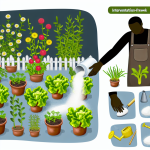The Secret to Long-lasting Asparagus Harvests
Planting asparagus can feel like a significant commitment, and in many ways, it is. However, the rewards far outweigh the initial work involved. Asparagus, once properly planted and cared for, will yield a bountiful harvest year after year for decades. Here’s how you can set yourself up for long-term success with this perennial delicacy.
Choosing the Right Location
When selecting a location for your asparagus, consider the following:
- **Sunlight**: Asparagus thrives in full sun. Ensure the chosen spot receives at least 6-8 hours of direct sunlight per day.
- **Soil**: Well-draining soil is crucial. Avoid areas where water tends to pool. Asparagus prefers sandy loam but can tolerate a variety of soil types as long as there’s good drainage.
- **Space**: Plan for the future. Asparagus plants spread with time, so ensure there’s enough space for them to grow without competition from other plants.
Preparing the Soil
Proper soil preparation is key for a thriving asparagus bed:
- **Testing**: Begin with a soil test. Asparagus prefers a pH between 6.5 and 7.5. Adjust the pH with lime (to raise) or sulfur (to lower) if necessary.
- **Amending**: Enrich the soil with plenty of organic matter. Compost or well-rotted manure is excellent. Work it into the soil to a depth of at least 12-18 inches.
- **Fertilizing**: Add a balanced fertilizer high in phosphorus and potassium to encourage strong root development.
Planting Asparagus Crowns
Asparagus is typically planted from one-year-old crowns:
- **Timing**: Plant crowns in early spring as soon as the soil can be worked.
- **Trench Digging**: Dig a trench 12 inches wide and 6-8 inches deep. For multiple rows, space the trenches about 3-4 feet apart.
- **Spacing Crowns**: Place the crowns in the trench, spacing them 12-18 inches apart. Spread the roots out over small mounds of soil within the trench.
- **Covering**: Cover the crowns with 2 inches of soil initially. As the shoots grow, gradually fill in the trench with more soil until it is level with the ground surface.
Maintaining Your Asparagus Bed
Maintaining asparagus is crucial to ensure decades of productivity:
- **Watering**: Keep the soil moist but not waterlogged. Deep watering once a week is preferable to shallow, frequent watering.
- **Mulching**: Mulch the bed with straw or wood chips to retain moisture and control weeds.
- **Weeding**: Remove weeds regularly to avoid competition for nutrients. Hand-pulling is best to prevent root disturbance.
- **Fertilizing**: Each spring, top-dress the bed with compost or a balanced organic fertilizer to replenish nutrients.
Harvesting Asparagus
Patience is required before you can start harvesting:
- **Initial Wait**: Do not harvest during the first two years to allow the plants to establish themselves.
- **First Harvest**: In the third year, harvest spears for a period of 2-3 weeks. In subsequent years, you can extend the harvest period to 6-8 weeks.
- **Harvest Technique**: Cut the spears at ground level when they are 6-8 inches high. Avoid damaging the crown when cutting. Spears that have grown too tall become woody and are best left to mature.
End-of-Season Care
Proper care at the end of the growing season sets up your asparagus bed for success in the following year:
- **Ferns**: Allow the ferns to grow and turn yellow in the fall before cutting them back. The ferns feed the crown and prepare it for winter.
- **Cleanup**: Clear away old fronds and mulch to reduce pest and disease risks. Add a fresh layer of mulch after the first frost for winter protection.
- **Monitoring**: Watch for asparagus beetles and other pests, treating as necessary to protect your plants.




GIPHY App Key not set. Please check settings